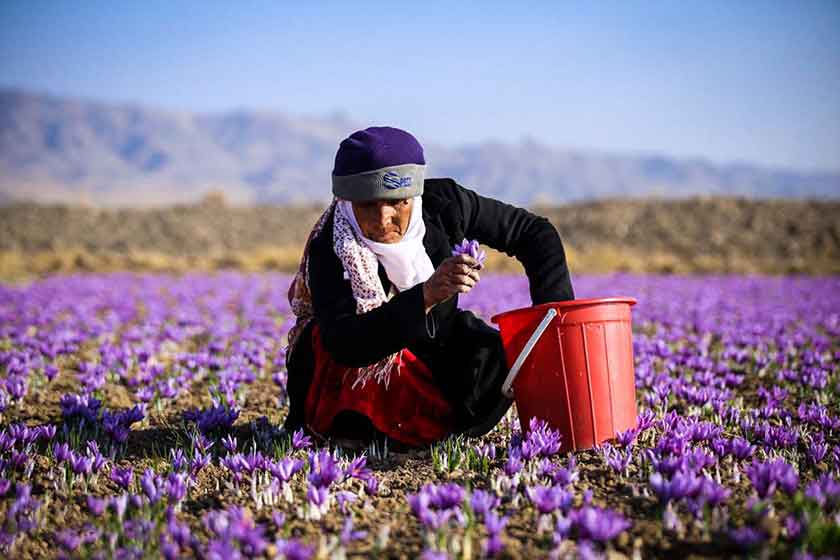

After picking the flower of saffron, due to its elegance and its corruptibility, it should be quickly applied to the separation and drying of the stigmas, because the quality and final value of saffron is determined in its drying method.
The traditional method of drying saffron
In this method, usually placed wedges in a basket or similar container that has a hole in the curtain and covered on it with a thin cloth. Then they put these baskets in a room that has a good heat, or they hang them from the ceiling, and every few days turn the saffron batches to dry.
Disadvantages of the traditional method:
1- Long drying time
2- Higher moisture content and increase the possibility of mildew
3. Increase the possibility of contamination with all types of microbes and foreign matter
4. Darkening of saffron color
Sieve and Heater Method:
This method is also known as the Spanish method, the system’s low cost and the support of the Ministry of Agricultural have made this method a common practice among Iranian farmers. The summary of the procedure for drying saffron is as follows:
1- Spreads of flowers from 150 to 200 grams are immediately transferred to ready-to-dry grates.
2- Establishment of a grid with a specified distance on a heat source that can provide 75 degrees of heat uniformly and indirectly under the net and without direct flame contact.
3- After setting the heat, put Saffron content lace on it for 15-20 minutes.
4. After 20 minutes, put another net on a lace containing saffron and rotate each round of the net so that the saffron is completely discharged in the second lining.
5. Repeat the grid on the device and repeat the same after 15 minutes.
6- After 3 or 4 times repeating, which lasts between 50 and 60 minutes, the saffron is dried inside the lace and should be transferred to a special storage container.
And in the end of each grid, 30 to 40 grams of dried saffron will be obtained at each stage. It is best to drain the dried sauce from the net directly onto the fabric so that the saffron is completely cooled. After cooling, the saffron is transferred to a clean, tight container and kept up to a cool place until delivered to the market.
Weaknesses and strengths of the sieve and heater method:
1- Due to the lack of precision in the amount of heat generated by heaters, saffron is occasionally burned and dropped due to consumers’ carelessness.
2- There is no possibility of humidity control.
3. The quality of the finished product is desirable.
4. The speed of its operation is considerable.
5. The price of the machine is low, so it can be used by farmers.
6. Due to the low capacity of the machine it is also possible to use it for small areas with low crop yields.
7- Group use by farmers
Drying of saffron by new devices with humidity control:
The best quality of dried saffron is created in terms of taste and strength of these types of devices under certain conditions.
In this method, silicates with a diameter of 30 cm and silk mesh are used. Place the saffron straws in a layer 2-3 cm thick on the lace and then place the sieve at a suitable distance from the heat source. By grading several sticks together and changing their position, the product is dried thoroughly and uniformly.
Benefits of drying saffron with industrial drying machines:
1. High drying speed
2. High output volume
3- Ability to use control systems to reduce errors
4. Low depreciation
5- Ability to control the amount of moisture – the amount of heat
6- Ability to use for other products (herbs, etc.)
Other Saffron Drying Techniques:
Electric oven:
Using an electric oven with a temperature of 60-50 degrees Celsius and special trays with silk mesh is another method of saffron drying. In this method, saffron is dried in a layer at a thickness of 1-2 centimeter for 30 to 40 minutes. In this method, the color and perfection of saffron is high.
Freeze dryer:
In this method, first place the product at -22 ° C to -18 ° C for 20 hours and then place at -13 ° C and a pressure of 0.1-15 mmhg for 12 hours. In this way, the amount of pigment crocin is a very high product. It should also be noted that the color of the saffron obtained will be reddish orange, which is not desirable due to the consumers’ inadequate mindset about the redness of saffron.
Solar Dryer:
This machine is made up of classes that have saffron spangles and are lost and dried by absorbing sun rays.
Air dryers:
Here the hot air comes in direct contact with the product. The most important of these are tunnel dryers. In this method, the cutter separates the stigma from the petals and passes through the thermal tunnel for 50% of its moisture, and then, using wind force, based on the difference in volume and passing through a The electrical device of the product is removed.
Vacuum Dryers:
These dryers are used for materials that have high heat to destroy their effective materials.



